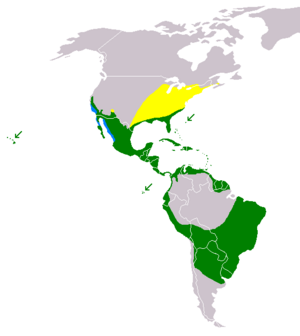Common gallinule facts for kids
Quick facts for kids Common gallinule |
|
|---|---|
 |
|
| Common gallinule on Santa Cruz. Galápagos Islands, Ecuador | |
| Conservation status | |
| Scientific classification | |
| Genus: |
Gallinula
|
| Species: |
galeata
|
| Subspecies | |
|
About 7; see text |
|
 |
|
| Range of G. galeata Breeding range Year-round range Wintering range | |
| Synonyms | |
|
Gallinula brodkorbi McCoy, 1963 |
|
The common gallinule (Gallinula galeata) is a cool bird that belongs to the Rallidae family. This family includes birds like rails and coots. The common gallinule used to be considered the same as the common moorhen, but scientists decided they were different in 2011.
You can find common gallinules living near watery places. They like marshes, ponds, canals, and other wetlands that have lots of plants. In North America, the common gallinule is one of the easiest rail birds to spot, along with the American coot.
Contents
What Does a Common Gallinule Look Like?
The common gallinule has mostly dark feathers. But it has a white patch under its tail. Its legs are yellow, and it has a bright red shield-like plate on its forehead. Young gallinules are usually browner and don't have this red shield yet.
These birds make many different gurgling sounds. If they feel threatened, they can also make loud hissing noises!
How Big Are They?
- Length: About 12.6 to 13.8 inches (32 to 35 cm)
- Weight: Around 10.9 to 16.1 ounces (310 to 456 g)
- Wingspan: About 21.3 to 24.4 inches (54 to 62 cm)
Where Do Common Gallinules Live?
Common gallinules are often found breeding in marshy areas and lakes with lots of plants. If they live in places where the water freezes, like southern Canada or the northern USA, they will fly to warmer places for the winter.
What Do They Eat?
These birds eat many different things. They munch on various plant materials. They also eat small creatures that live in the water.
Gallinules look for food right next to or in the water. Sometimes, they even tip their bodies upside down in the water to reach food. Their wide feet help them walk easily on lily pads and other floating plants.
Even though they can be shy, some gallinules become quite used to people in certain areas. Even if some of their homes are lost, common gallinules are still found in many places and are not rare.
Common Gallinule Family Life
Common gallinules will fight to protect their home area. They build their nests on the ground, hidden in thick plants.
Eggs and Chicks
Laying eggs usually starts in spring. This is between mid-March and mid-May in cooler northern areas. A female gallinule usually lays about 8 eggs early in the season. Later in the year, a group of eggs might only have 5 to 8, or even fewer. Sometimes, different female birds might use the same nest.
The eggs take about three weeks to hatch. Both parent birds take turns sitting on the eggs to keep them warm. They also both feed the young chicks.
The young birds can fly after about 40 to 50 days. They become independent a few weeks after that. They might even have their own babies the very next spring! If danger is near, young gallinules might hold onto a parent's body. Then, the adult bird can fly away to safety, carrying its chicks with it.
Different Types of Gallinules
Scientists recognize seven different types, or subspecies, of common gallinules today. The differences between them are often small. Usually, knowing where you see a gallinule helps tell you which type it is. But remember, these birds can fly to different places!
Here are some of the different types of common gallinules and where they live:
- Southern American common gallinule (G. g. galeata): Found in places like Trinidad, the Guyanas, and parts of Brazil and Argentina.
- Andean common gallinule (G. g. garmani): Lives in the Andes mountains, from Peru to northwest Argentina. This type is a bit bigger.
- Hawaiian gallinule (G. g. sandvicensis): This type is only found in the Hawaiian Islands. In Hawaiian, it's called ʻalae ʻula. It has a large red shield on its forehead.
- Antillean common gallinule (G. g. cerceris): Found in the Caribbean islands (except Trinidad and Barbados) and also in south Florida. It has a long beak and big feet.
- North American common gallinule (G. g. cachinnans): This is the type you'd find from southeast Canada, through the US, to west Panama. It's also in the Galápagos and Bermuda.
- Subandean common gallinule (G. g. pauxilla): Lives in lowland areas from east Panama south to northwest Peru. This type is smaller.
- Barbados common gallinule (G. g. barbadensis): This type is only found on the island of Barbados. It has a lighter head and neck.
Images for kids
-
A common gallinule in Everglades National Park
-
Adult gallinule with its chick in Florida
-
A common gallinule standing at Rodrigo de Freitas Lagoon, Brazil
-
A common gallinule walking at Costanera Sur Ecological Reserve, Argentina










